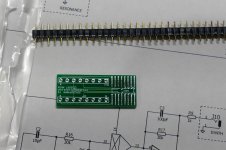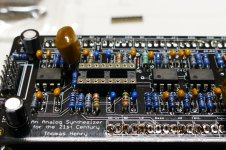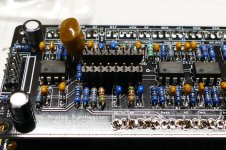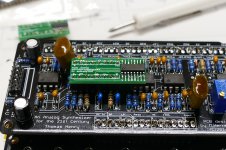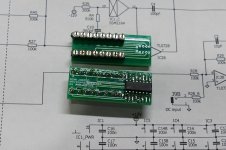I would like to put a SOIC-8 IC into a board that has DIP-8 sockets. I can find the little adaptor PC boards, no problem. But I am having difficulty locating PINS to solder into the PC adaptor board that will then insert into the DIP-8 socket. Does anyone know where I can find these?
929700-01-20 3M Electronic Solutions Division | Mouser
Just one example, Mouser has oodles of variations on this.
Oh, on second thoughts maybe those aren't correct as you need pins that mate with sockets, not with PCB holes. Let me look again.....
These Samtec ones look like the pins are round, so will fit better into IC sockets (so long as they're not turned pin sockets which might not accept them) : https://www.mouser.com/datasheet/2/527/ts-1360359.pdf
Just one example, Mouser has oodles of variations on this.
Oh, on second thoughts maybe those aren't correct as you need pins that mate with sockets, not with PCB holes. Let me look again.....
These Samtec ones look like the pins are round, so will fit better into IC sockets (so long as they're not turned pin sockets which might not accept them) : https://www.mouser.com/datasheet/2/527/ts-1360359.pdf
Last edited:
Thanks for your reply! Those look like exactly what I need, but boy are they expensive!! Even getting 32-pin versions to cut down for DIP-8 insertion, I'm looking at 57.5¢ per IC!! Damn, that's more $$$ than the sockets!! Hmmmm.....Oh, on second thoughts maybe those aren't correct as you need pins that mate with sockets, not with PCB holes. Let me look again.....These Samtec ones look like the pins are round, so will fit better into IC sockets (so long as they're not turned pin sockets which might not accept them) : https://www.mouser.com/datasheet/2/527/ts-1360359.pdf
Yeah I agree, Samtec has never been cheap in my memory. This guy on Taobao is looking much cheaper : ?? ????? ???????? SO-8?DIP-8 ???????-???
Well, it appears that would be a bargain. But I was unable to log in, "Buy Now" or "Add to Cart". Have you any success in doing so?This guy on Taobao is looking much cheaper : ?? ????? ???????? SO-8?DIP-8 ???????-???
My wife does all my ordering for me on Taobao. Google for 'Taobao agent' you can have someone buy it and ship it to you for a fee.
I would like to put a SOIC-8 IC into a board that has DIP-8 sockets. I can find the little adaptor PC boards, no problem. But I am having difficulty locating PINS to solder into the PC adaptor board that will then insert into the DIP-8 socket. Does anyone know where I can find these?
I use molex headers and cut to size on my adaptor pcb.
These are what you are looking for:
US Stock 10pcs 2.54mm Male 40 Pin Single Row Round Header Strip Gold Plated New
My search term on eBay eludes me (maybe Round Pin Header?), but you can carefully find other listings by looking for the same construction features in the picture. There are female mating sides that you can use on the PCB - a normal Mill-Max collet socket works fine too.
US Stock 10pcs 2.54mm Male 40 Pin Single Row Round Header Strip Gold Plated New
My search term on eBay eludes me (maybe Round Pin Header?), but you can carefully find other listings by looking for the same construction features in the picture. There are female mating sides that you can use on the PCB - a normal Mill-Max collet socket works fine too.
Mouser:
350-10-120-00-006101 Preci-dip | Mouser
Correct size round pins for DIP socket, 20-pin, $2.58, cut-to-length, good for 2 1/2 DIP adapters.
350-10-120-00-006101 Preci-dip | Mouser
Correct size round pins for DIP socket, 20-pin, $2.58, cut-to-length, good for 2 1/2 DIP adapters.
It's not clear what the DIAMETER of those pins are. So I asked the seller a question on eBay. We'll see. Looks like Mill-Max sockets will take up to a 0.025 ROUND pin, but only a 0.018 SQUARE one.
Thanks for the tip!! Those look good, and are ~ 25% less $$$ than the Samtecs. Still, ~94¢ per I.C.!! Sure makes those damn SOIC-8 ICs costly!!Mouser:350-10-120-00-006101 Preci-dip | Mouser
Correct size round pins for DIP socket, 20-pin, $2.58, cut-to-length, good for 2 1/2 DIP adapters.
Last edited:
Yah, hardware bits can be more expensive than the actual electronic parts, but if it's the only choice, it has to be done. Also relative to chip cost: for a $2-3 chip it's expensive, but for a $10-15 chip not so much.Thanks for the tip!! Those look good, and are ~ 25% less $$$ than the Samtecs. Still, ~94¢ per I.C.!! Sure makes those damn SOIC-8 ICs costly!!
You can find them quite a bit cheaper from Asian sources, but then you have to put up with long shipping times, or pay a shipping premium.
DON'T use .025" square header pins in a socket, they can/will permanently distort the spring contacts in high quality sockets (Mill-Max, etc.).
Also relative to chip cost: for a $2-3 chip it's expensive,
I have a problem using a $1 IC socket for a 25 cent opamp.
I need an adapter to put a SOIC 16 into a 16 pin DIP socket. There are several reasonably priced choices on Amazon for breadboard use, but they are a no-go for the DIP socket since the pin spacing is too wide.
I did find these, and some reasonably priced pins that should fit into the existing Millmax IC socket, but as with all things like this from Amazon or Ebay, you won't know for sure until it's in your hand...which should be Thursday.
Amazon.com: NKC Electronics SMD SOIC 16 to DIP Adapter 1.27mm Narrow and Wide SOIC-16 to 300mil DIP PCB Adapter. Breadboard Friendly: Computers & Accessories
Amazon.com: Generic 2.54mm 40p Single Row Break Away Headers Machine Pin Male(pack of 10): Beauty
PLEASE keep us posted as to how well this worked; especially the pins. They DO look like they'll fit nicely into a Mill-Max socket, but, as you said, you never know......Thanks, George!I did find these.....reasonably priced pins that should fit into the existing Millmax IC socket, but as with all things like this from Amazon or Ebay, you won't know for sure until it's in your hand...which should be Thursday.
The pins fit properly into a "machined pin" IC socket. I used MillMax.
I have been slowly building a modular analog music synthesizer. It uses some module kits that feature parts that went extinct in the 1980's or 90's. The recent popularity of DIY music synthesis has resulted in a couple companies producing reissues of these old chips, but often in SMD only packages.
Behringer has been designing and building "clones" of many of the popular music synthesizers from the 70's and early 80's. They have their own IC company making the reissue chips. These chips are also available to the DIY market under the Cool Audio brand. I have TWO DIFFERENT reissues of the old Solid State Music SSM2164 chips, so I built two of these adaptors for some "chip rolling."
My already populated board has a fat yellow cap right where the board would go, so I built these backwards. Pin 1 and pin 9 are swapped. All appears to be OK DC voltage wise, but I have not actually applied signal to the board yet since I need to swap out some incorrectly installed capacitors. I got pF and nF mixed up.
Here are some pictures.
I have been slowly building a modular analog music synthesizer. It uses some module kits that feature parts that went extinct in the 1980's or 90's. The recent popularity of DIY music synthesis has resulted in a couple companies producing reissues of these old chips, but often in SMD only packages.
Behringer has been designing and building "clones" of many of the popular music synthesizers from the 70's and early 80's. They have their own IC company making the reissue chips. These chips are also available to the DIY market under the Cool Audio brand. I have TWO DIFFERENT reissues of the old Solid State Music SSM2164 chips, so I built two of these adaptors for some "chip rolling."
My already populated board has a fat yellow cap right where the board would go, so I built these backwards. Pin 1 and pin 9 are swapped. All appears to be OK DC voltage wise, but I have not actually applied signal to the board yet since I need to swap out some incorrectly installed capacitors. I got pF and nF mixed up.
Here are some pictures.
Attachments
Excellent! Thanks for reporting; I'll order some of the pins ASAP. Which MillMax socket are you using? I've been debating between the ones with gold "flash" contacts vs. the ones with 10µm gold plating. There's an almost x2 price difference. Seems to me that the "flash" is good enough unless you need to swap out the IC dozens of times or more. What do you think?The pins fit properly into a "machined pin" IC socket. I used MillMax.
Which MillMax socket are you using?
Now you ask a hard question. I went to look over the bench where I have been assembling modules for my Eurorack modular off and on for several months. I have found two open packages of 16 pin sockets, both with sockets missing. I'm not really sure which one was used in that picture.
One package is Mill-Max 210 47-316-41-00100 Digikey ED11148-ND They are about 85 cents each in qty 10 at Digikey or Mouser.
The other package is Omron XR2A-1611-N They are about $2 each today, and I wouldn't pay that much, so I looked up the order number. I bought them in April 2015 when they were $1.10 each.
Back in the mid 70's myself and several friends were building clones of the SWTPC (Tiger amps) 6800 computer system. We lived in hot and humid south Florida and we had trouble with the cheap tin plated IC sockets of the day. What we thought was bad memory chips turned out to be intermittent sockets. This taught us to not use sockets for cheap chips, and to use decent sockets for the expensive chips. I still stick to this process.
Looking at the board I just built, there are no sockets on the opamps. The only reason for changing them would be if I blew one. I would just cut the old one out, remove each pin from the board, clean the holes, and put in a new one.
"flash" is good enough unless you need to swap out the IC dozens of times or more. What do you think?
Here the quad VCA chip is socketed because an adaptor must be used, and I have two different brands of SOIC chips to try. I don't think I will be swapping chips often either, so I spent about $0.85 each for a dozen decent Mill-Max machined pin sockets from Digikey two weeks ago. I have never had one of them go bad, unless I did something stupid to it. Looking at the board, the other completed boards, and the sockets remaining in the packages, I'm 90% sure the new Mill-Max socket is in the board in the photo.
An excellent point! Reminds of the days when I worked in a video post-production house that had a video processor (Vital SqueezeZoom) that was built in Gainesville, Florida I believe. A wonderful video tool, but it was plagued by exactly what you described---cheap intermittent sockets---had to do a "sweep" of the boards every morning---literally sweeping your hand fan-like across the card cage to shake them up. The factory finally sent a tech out to work with me to rectify the problem, and we spent 50-60 hours/week for three weeks changing out them sockets!! Lesson learned also!! But these were certainly NOT Mill-Max quality machined sockets, which I'll stick to.Back in the mid 70's myself and several friends were building clones of the SWTPC (Tiger amps) 6800 computer system. We lived in hot and humid south Florida and we had trouble with the cheap tin plated IC sockets of the day. What we thought was bad memory chips turned out to be intermittent sockets. This taught us to not use sockets for cheap chips, and to use decent sockets for the expensive chips. I still stick to this process.
- Home
- Design & Build
- Parts
- Pins for SOIC-to-DIP adaptor
